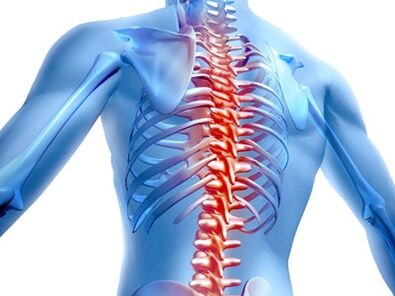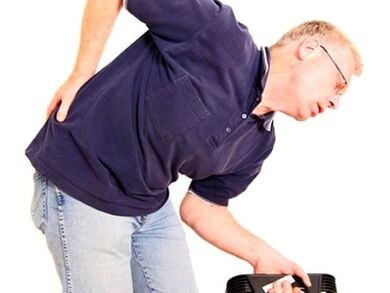
Osteochondrosis is a widespread and rapidly "rejuvenating" disease that affects many people around the world.
These are degenerative changes of a dystrophic nature in the bone tissue of the spine, its joints, cartilage and ligaments.
For a while a person may not notice the disease, but the signs of osteochondrosis become noticeable fairly quickly: the spine becomes pathologically mobile, injures nerve endings, blood vessels, even adjacent tissue, causing severe pain.
When the disease begins, the rapidly growing bony processes continue to damage the nerve roots and blood vessels.
Symptoms are mainly due to the location of the disease.
The main symptoms of the disease
Usually all symptoms are cataloged into four large groups and assigned to both the affected area and the individual characteristics of each patient's spine. It should be noted that if a person is hypothermic, has a cold, is under severe stress, abuses alcohol, eats irregularly or incorrectly, and also does not normalize physical activity, the manifestations of the disease can increase noticeably.
- Static symptoms depend on a change in the shape of each vertebra, which leads to a deterioration in posture: a person develops scoliosis or even kyphosis with lordosis, usually unable to straighten their back and turn their head freely. The spine loses its flexibility.
- Neurological symptoms represent damage to the nervous tissue, in which not only the force of muscle contractions is disturbed, but also the sensitivity of the skin is violated. The roots of the spine are compressed, there is pain, numbness, tingling, feeling of horror in the affected area. When the disease begins, limb paresis can occur (partial loss of mobility or even total paralysis).
- Vascular symptoms develop for two reasons. First, by the compression of arteries with veins (especially in cervical osteochondrosis, when the arteries supplying the brain are compressed), which leads to a noticeable deterioration in the blood supply to the brain, the appearance of nausea, dizziness and a lack of oxygen in certain areas. Second, by irritation of the nerve fibers, a change in the state of the sympathetic nervous system develops. The result is spasms of many vessels, even ischemia.
- Trophic symptoms occur when the above neurological manifestations overlap the vascular symptoms. As a result, tissue nutrition becomes much worse, which leads to the appearance of ulcers.
When osteochondrosis of the neck develops

The signs of osteochondrosis vary depending on which area of the body is affected. Cervical osteochondrosis is a dangerous and insidious enemy. First, there is a headache for which analgesics just don't work.
Painful sensations can affect the back of the head and temples, intensify after a person is in a calm state with no movement, and hurt not only the head itself, but also the skin. Then there are painful sensations in the arms and shoulders, the sensitivity of these areas is disturbed.
If you do nothing, the case can end in hand paralysis.
In addition to pain, cervical osteochondrosis is accompanied by other symptoms:
- Nausea, unpleasant noises, unexpected dizziness.
- Worsening vision, flies in front of the eyes (all this is a consequence of a violation of proper nutrition and metabolism in the optical system).
- Fainting due to lack of oxygen in the brain, shaky, unsteady gait.
- Hiccups, shortness of breath (when the phrenic nerve is affected), lump in the throat.
- Limited mobility of the neck, painful sensations in it, constant muscle tension.
- Trophic changes in the skin on the hands.
- Constant weakness, powerlessness and tiredness, frequent irritability, feeling hot or, conversely, chills.
Very often a lesion of the cervical spine is mistaken for stroke, high blood pressure, a problem with the ENT organs, and even neurasthenia.
When the chest region is affected
When it comes to the chest area, it is easy to imagine the symptoms that accompany the condition if you remember which organs may be affected. This department is affected relatively rarely, it is difficult to identify the disease, since the signs are easily confused with the manifestations of other problems.
First, there is pain between the shoulder blades or in the chest, in the upper abdomen. It can involve internal pain and can be mistaken for angina, colon or renal colic, or liver problems. Then it all depends on the department concerned:
- If the upper chest is affected, swallowing problems, a lump in the throat and a cough occur.
- The defeat of the middle chest region causes pain similar to the manifestation of gastritis, peptic ulcer and heart problems. Cardiac arrhythmias appear, blood pressure rises.
- When the lower breast segment suffers, the bowel function is disturbed, the pain resembles the manifestations of appendicitis.
- There are also painful sensations in the heart, increased heartbeat, shortness of breath, an uncomfortable feeling of cold, burning or tingling in the chest and stomach.
The main problem is not that osteochondrosis can be confused for a long time with myocardial infarction, angina, abdominal disease or pneumonia, but that a person tries to breathe more accurately because of pain, thereby saving himself a vicious circle: pathology of the respiratory tract, chronic respiratory failure, Heart damage.
When the lower back is affected

The lumbar area most often suffers because it receives the greatest loads not only when moving, when moving, but also when lifting heavy objects. The problem with the lumbar region is most noticeable with painful sensations not only in the lower back, but also in the lower extremities, leads to numbness of the skin on the legs. Then additional symptoms appear:
- If the motor fibers are affected, paresis can occur and the case ends in paralysis of the legs.
- The defeat of the nerves causes not only pain in the lumbar spine, but also severe lumbago after any exercise.
- If the pelvic functions are impaired and the blood flow to the pelvic organs is disturbed, people not only suffer from pain, but also from difficulty urinating (in men also with an erection), from fecal incontinence.
Most often, physical activity, sudden movements, and hypothermia become the triggers for the onset of pain. The roots are compressed, the intervertebral discs are displaced. The person begins to experience aching, dull, or, on the contrary, stabbing pain.
Often times, painful sensations affect not only the lower back, but also the area of the buttocks, thighs, legs, and even the feet. In advanced cases, the lower extremities may decrease in volume.
Conclusion
Whatever areas osteochondrosis is affected, it is always a very serious condition that requires the active participation and intervention of doctors. Despite various signs, its main manifestations are severe pain and movement disorders. Sensations of pain are "disguised" as manifestations of other illnesses, so most often people turn to cardiologists, therapists, or gastroenterologists first because they suspect they are diagnosed with problems with the heart, digestive tract, or other organs.
It is necessary to contact a neurologist first, and it is advisable to do so before there is pain that is characteristic only of osteochondrosis and even more other signs (such as paresis and paralysis). First of all, the doctor will ensure the elimination of pain (prescribe various painkillers), improve metabolic processes in all tissues (both cartilage and muscle tissue, and in nerve tissue), and eliminate hernias if they have already formed.
In addition to medication, the patient is prescribed massages, compulsory physical education and various physiotherapeutic measures.





































